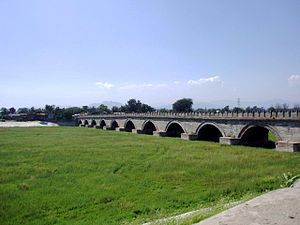The Yongding River (Chinese:
| Yongding River | |
|---|---|
 The Yongding River under the Marco Polo Bridge is dried out | |
 The Hai River Basin. | |
| Native name | |
| Physical characteristics | |
| Source | Guancen Mountains |
| • location | Ningwu County, Shanxi Province |
| Mouth | Hai River |
• coordinates | 39°09′44″N 117°10′34″E / 39.1623°N 117.1762°E |
| Length | 650 kilometers (400 mi) |
| Basin size | 47,016 square kilometers (18,153 sq mi) |
| Basin features | |
| Bridges | Marco Polo Bridge |
 | |
Etymology
editThe river was originally called Wuding River (Chinese:
Geography
editThe Yongding River is 650 kilometers (400 mi) in length and drains an area of 47,016 square kilometers (18,153 sq mi). It emerges from the Guancen Mountains (
In Huailai County, it fills the Guanting Reservoir, the biggest reservoir serving Beijing, and takes on the name Yongding. It enters Beijing Municipality through the Xishan Mountains west of the city in Mentougou District and descends into the flatlands of Fengtai and Daxing Districts.
The river eventually flows back into Hebei Province and then on to Tianjin Municipality, where it meets the Hai River just before the latter enters the city and then empties into the Bohai Sea at Tanggu. Part of the river is diverted before the juncture with the Hai, and flows directly into the Bohai Sea. This channel is called the Yongding New River (
History
editHistorically, the river was notorious for its flash floods and course changes. The river has taken at least three major courses through Beijing. According to the earliest historical records, the river originally flowed northeast from Babaoshan toward what is now the Purple Bamboo Park in Haidian District and into Wenyu River.
- Western Han dynasty
In the Western Han dynasty, the river flowed south from Deshengmen through what is now downtown Beijing, including Qianmen and Hongqiao and Longtan Lake, before leaving to the southeast. At that time, the city was southwest of today's city center. In the Liao dynasty, the river moved southwest to its present course, and the Lugou Bridge was built over it in 1189. When Marco Polo visited the city during the Yuan dynasty, he crossed the Yongding River on the Lugou Bridge, which became known as the Marco Polo Bridge.
- Qing dynasty
The river has been known colloquially as the Wuding River or the "River of Instability." In 1698, the Qing dynasty Kangxi Emperor's government reinforced the river banks and rendered the current course permanent. Thereafter it became known as the Yongding River or the "River of Eternal Stability."[4]
Gallery
editSee also
editReferences
edit- ^ Jiang, Bo; Wong, Christina P.; Lu, Fei; Ouyang, Zhiyun; Wang, Yajuan (2014). "Drivers of drying on the Yongding River in Beijing". Journal of Hydrology. 519: 69–79. Bibcode:2014JHyd..519...69J. doi:10.1016/j.jhydrol.2014.06.033. Archived from the original on 2020-07-23. Retrieved 2019-07-06.
- ^ Hancock, Tom (2011-09-22). "Slideshow: reviving the Yongding". Chinadialogue.net. Chinadialogue.net. Retrieved 2017-01-29.
Beijing's government is spending 16 billion yuan (US$2.5 billion) on restoring the dried-out riverbed, filling it with water and creating parkland along the riverside.
- ^
小 溪 (2009-11-29). "康 熙与南 惠 济庙". china.com.cn (in Chinese). Beijing Daily. Retrieved 2018-03-07.永 定 河 之 称 谓始于康熙朝。康 熙皇帝 勤 政 ,为人所 共 知 ;康 熙皇帝 大力 治 理 浑河,将 "无定河 "改名 为"永 定 河 ",亦 见诸史 册 。 - ^ Li, Lillian M. (2007). Fighting Famine in North China: State, Market, and Environmental Decline, 1690s-1990s. Stanford University Press. pp. 41–43. ISBN 978-0-8047-5304-3.